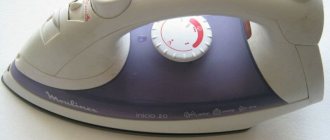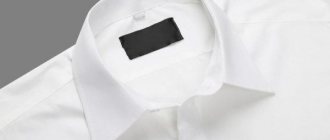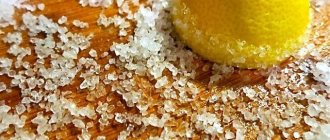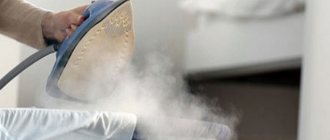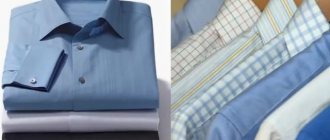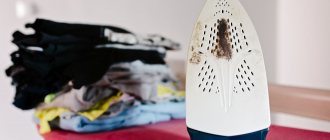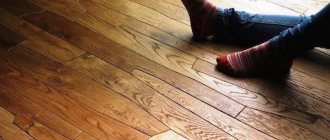What will you need?
It is impossible to iron a shirt without special equipment. Therefore, before you start ironing the product, you need to prepare the following:
- iron with steamer. If this function is not available, you can use a spray bottle with water. It is important that the base of the device is clean, free of soot, scale and rust. A dirty iron can ruin a shirt, especially a light-colored one.
- ironing board with cover. An additional advantage will be the ability to adjust its height. If you can’t use the board, you can replace it with a flat table covered with a light, dense fabric without a pattern.
- stand for ironing sleeves of shirts and sweaters. It usually looks like a small ironing board and comes with it. This is not a necessary device, but it will make ironing sleeves and cuffs much easier, faster and with better quality.
- ironing spray. These products can be bought at a household chemical store or made independently from available ingredients (a solution of 1 tablespoon of starch in 1 liter of water). Thanks to them, the ironing effect lasts much longer, and the process itself becomes easier.
- vertical steamer. They can easily smooth out wrinkles and bruises without the risk of burning the product.
- office clips. It is not necessary to use them. Clips will help to secure the sleeves evenly if you need to make arrows on them.
You will also need a little patience and free time. You cannot rush in this matter, because there is a risk of ironing the shirt poorly or burning it.
Wash
To ensure that clothes, bed linen, curtains and other household and interior items are always pleasing to the eye, you need to wash them periodically. The latter matter cannot be treated carelessly, because an incorrectly washed item can only fit on a doll. In order to avoid disaster, cotton items are divided into groups in advance and in no case are they mixed.
The principles of tissue classification are simple and straightforward:
- Separation of clothes by color: undyed and colored.
- And by the type of material (thick homespun; thin, such as muslin or tulle; complex fabrics, with pile or fleece, which include corduroy. Not only clothes are made from this material, but also upholstery for furniture; materials made from pure cotton or cotton mixed with synthetics. Due to their joint washing, pilling will appear on the clothes).
Thin and complex fabrics require a special approach so as not to spoil them after washing.
- General rule for all types of cotton fabrics. Read the tag before putting clothes into the drum. The tag must contain care recommendations, from which it is advisable not to deviate. If it is written that a certain temperature is suitable for washing, then you cannot exceed it; it is better to let the water be colder than necessary, otherwise the cotton will shrink. He can be moody sometimes.
- Typically, cotton fabrics are washed at a temperature of 40 O C. Hot water exceeding 60 – 65 O C causes clothing to shrink significantly. The duvet cover and some other items of clothing and linen should first be placed in a special bag.
- White cotton items are washed at temperatures up to 95 O C. Heavily soiled clothes are pre-soaked in soapy water. Any detergent is suitable, including environmental bleaches. The spin cycle can be turned on at maximum power, but it is better to refuse automatic drying.
- Colored cotton fabrics are washed at the same temperature as white ones. Even the highest quality and most stable dyes will not be able to withstand temperatures of 65 OC or more. Before washing, the outfit must be carefully inspected and stains that are difficult to wash off must be removed; for this purpose, the stains are treated with special products and the fabric is soaked. It is not for nothing that it is forbidden to wash white and colored items at the same time, in the same drum - an initially undyed item can change color from such proximity. You can check how durable the paint is on a colored item by soaping a piece of it and rubbing it on a white piece of cloth, but it’s even better to simply not wash clothes of different colors at the same time, in the same place. A new item should be washed by hand first. Detergents should be designed for colored fabrics. Bleach is contraindicated. It should be dried not in a machine, but on clotheslines.
- Thin materials are washed in warm water, the temperature of which does not exceed 65 O C. Lace fabrics are cleaned of dirt only by hand, coupled with soaking in soapy water for 6 hours. In the case of automatic washing, the choice should fall on the mode for delicate fabrics, with drying disabled. It is also advisable not to entrust spinning to a machine, as it can cause damage to things. You need to wring out the item with extreme caution, rolling it into a roll and pressing lightly on it until the excess water comes off.
- Complex fabrics. For them, it is recommended to wash them exclusively by hand; when processed by machine, such cotton will lose its presentable appearance. Corduroy is not washed, but stains are carefully removed with a brush. Instead of the usual hard squeezing with twisting, there are light gentle touches that do not allow kinks. You can’t wash corduroy in a machine with such washing requirements.
Colored cotton is washed at a temperature no higher than +65 degrees
Preparing the Shirt
A few tips to help you prepare your shirt for ironing and achieve a quality result:
- wash the shirt and remove all stains, otherwise the dirt will penetrate even deeper into the structure of the fabric under the influence of temperature. Then it will be almost impossible to remove them.
- It is best to dry your shirt on hangers, this way it will retain its shape and wrinkle less. You need to fasten all the buttons, straighten the cuffs and collar. If you hang the product to dry on a rope or radiator, folds will form on it; ironing it will take more effort and time.
- if the product is completely dry, spray it with distilled water from a spray bottle. But it is best to iron a slightly damp shirt that is not completely dry.
- Silk, especially artificial silk, cannot be ironed with steaming; only dry ironing is allowed from the reverse side.
- Delicate materials should be ironed through chintz or satin fabric; gauze and waffle towels should not be used as lining - they may leave marks.
- trim all protruding threads and remove lint. The most convenient way to do this is with a roller for cleaning clothes. This way, dust will not stick to the iron.
- Turn items with any accessories, embroidery, or convex pattern inside out. The soleplate of the iron can be damaged if you run it over such decor.
- read the instructions carefully. The label indicates all the necessary information about caring for the item, including the mode in which it should be ironed.
Caring for cotton products
Special care is required for cotton products, items and clothing if they are made in different colors and shades. It is worth noting that when exposed to high temperatures, colorful designs will simply move away from the material and fade (very important for red and dark products). Such items should be washed separately, setting the temperature no higher than 40-50 degrees.
In this case, you should avoid pre-soaking - just turn it inside out and fasten zippers, buttons and other fasteners. The recommended detergent is a high-quality powder intended for colored clothing.
Temperature selection depending on fabric type
People don’t always save tags from clothes, because they can cause unpleasant sensations when worn: pricking, tickling, and if the shirt is see-through, it can also spoil the appearance.
In this case, the heating mode of the iron is determined by the type of fabric:
- 100% cotton. This material is quite dense and durable, so you can iron a cotton shirt at temperatures up to 200°C. The optimal mode is two, but if you can’t iron the fabric, it is recommended to turn on the three. On most modern models of irons, next to the dots indicating the main modes, there are additional inscriptions: you can iron a cotton shirt in the “cotton” mode;
- cotton fabrics with impurities. Usually they are allowed to be ironed in pairs. However, the temperature depends on the material mixed with the cotton. Thus, flannel shirts can be ironed at 110°C, jacquard - at 130-140°C;
- denim is especially popular in informal clothing styles. You can iron it on a two-piece, if the material is thick enough - on a three-piece. Before the procedure, the denim product must be turned inside out and moistened generously with water - this will prevent the appearance of faded areas;
- viscose. Women's shirts are usually made from this lightweight material. Viscose should be ironed single or double, at a temperature of 120°C;
- linen, like cotton, is resistant to high temperatures, so it can be ironed on a triple iron;
- Poplin is what shirts for everyday wear are most often made from. This dense fabric can be ironed on a double iron, at a temperature of about 120°C.
- Oxford is a dense synthetic fabric that can be ironed at a temperature of no more than 110°-120°C, that is, at one.
- silk is a fabric that is very capricious and short-lived, not suitable for everyday wear. Silk shirts can be ironed from the reverse side on the single or “silk” mode - at a temperature of about 100°C, without using a steamer.
Attention! If it was not possible to determine the type of fabric, it is better not to risk it and iron the product on one piece. If your clothes are not ironing well, increase the temperature slightly. If the fabric begins to slow down the iron, you must immediately turn down the setting. It may take more time and effort, but the shirt will remain intact. The denser the fabric, the higher the temperature should be.
How to iron a cotton jacket. HOW TO IRON A JACKET?
- It happens that you are traveling at rush hour, on a bus, in a new windbreaker, in clean shoes and with a beautiful hairstyle. And the crush is such that you can stand and dangle your legs. You get out of the carriage and look as if the whole world hates your jacket, and passengers without children and who are not disabled especially hate it. And now you are not in a jacket, but in a crumpled rag.
Or, it happens, you hang a jacket in the closet, but in the closet it’s like in a jacket storage room - it’s already the eighth one and it’s not welcome. And she hangs there and thinks all night about her difficult fate. And in the morning you put it on, wrinkled like raisins from quiche-mish grapes, look in the mirror and realize that you have a difficult fate today.
Or, sometimes, he got into the car wearing a down jacket. He sat down very sloppily and abruptly. Because it’s 7 am and -20C at the same time. And so I sat for 3 hours. Because it’s 7 am, -20C and a hell of a traffic jam at the same time. And when I got up, it would have been better not to get up, because from behind you look like you weren’t driving in a car, but were sleeping in the hayloft.
So what are we talking about... Oh yes! Has your down jacket, windbreaker or insulated jacket become wrinkled in the most unimaginable way? Let's teach you how to iron! Because ironing is the most effective way.
Iron temperature
It’s easier to understand here than in the cockpit of an airplane. We determine the type of fabric and set the appropriate temperature. But! Be sure to check the label on the jacket; this information may already be written there. And if the iron icon is crossed out, then it is absolutely forbidden to iron such a jacket.
So, in short, linen and cotton are ironed with a hot iron, and synthetic fabrics and lace are ironed with a warm iron. And if in detail, then:
· Flax: 190-230 C
· Cotton: 160 – 190 C
· Wool: 140 – 165 C
· Natural silk: 115 – 140 C
Viscose: 85 – 115 C
If you are the happy owner of an iron on which the degrees are encrypted with dots, then here is the solution:
· One point – iron temperature no more than 110 C
· Two points – 150 C
· Three points – 200 C
It happens that the puzzle with dots is complicated, and the dots are divided into temperature intervals:
· One point: maximum temperature – 115 C; minimum – 75 C; nominal – 95 C.
· Two points: maximum temperature – 155 C; minimum – 105 C; nominal – 130 C.
· Three points: maximum temperature – 205 C; minimum – 145 C; nominal – 175 C.
If you happen to be an even happier owner of an iron not only with dots, but also with mysterious English words, then here is the transcript:
· “Nylon” and “silk” opposite one point – low-temperature mode, for ironing thin light fabrics such as nylon, silk, chiffon.
· “Wool” opposite two dots – medium-temperature ironing mode, suitable for woolen and wool-blend products.
· “Cotton” and “linen” opposite the three dots – high-temperature mode, which is recommended for thick, durable fabrics such as cotton or linen.
And it happens that the iron has not three modes, but as many as five. Then they look like this: “nylon”, “silk”, “wool”, “cotton”, “linen”. That is, the principle is the same.
Secrets and tricks of ironing jackets
To prevent the jacket from becoming shiny from the iron (this is especially true for dark fabrics), iron it through a cotton iron (in ancient Soviet times, gauze was used for this purpose, but now many stores sell miracle irons). Instead of an ironing iron, you can also use a special fluoroplastic iron sole.
Important!
The iron must be made of cotton fabric. No admixtures of synthetic fabrics are allowed! The best choice is calico. Wet calico is an even better choice because it makes ironing much easier. Precisely wet, and not a spray bottle, because splashes from it can leave marks after drying. If your grandmother taught you to take a mouthful of water and then create a fine fountain with your mouth, then thank your grandmother and never do that. The effect is exactly the same as from a spray bottle, although, of course, there are incomparably more emotions.
How to iron a long sleeve shirt?
In order for the product to look neat, it must be ironed correctly, without missing a single detail. Ironing long-sleeve shirts is a little more difficult and takes longer than short-sleeve shirts.
There is a certain procedure that will allow you to iron a men's long-sleeved shirt with high quality without missing a single detail.
Collar
The first step is to iron the smallest detail - the collar. If you iron most of the piece first, it will wrinkle while the rest of the pieces are ironed.
You need to iron your shirt collar as follows:
- If possible, remove the seeds.
- Stretch the piece on an ironing board; there should be no wrinkles.
- Iron from the edges to the middle on the front side.
- Fold the edges of the collar inward so that it stands up.
- If the part should not be standing, it can be ironed along the fold in the middle.
Sleeves and cuffs
After the collar, you need to iron the sleeves and cuffs of the shirt.
Ironing shirt sleeves is quite difficult because they easily lose their shape. To iron them efficiently, you need to adhere to the following algorithm:
- Pull the bottom seam to ensure there are as few wrinkles as possible on the garment. If you have a stand, iron the sleeve by pulling it over the fixture.
- Iron the cuffs on both sides: from the inside and from the face. The area of fabric near the buttons must be ironed especially carefully so that the iron does not touch them.
- After securing the sleeve with a paper clip, iron it from the front. You need to move the iron in the direction from the center to the edge, very carefully, without sudden jerks. Otherwise, the fabric may move and new folds will appear on it.
- Repeat the same on the reverse side.
- Make arrows if desired. To do this, you need to apply the iron several times for 2-3 seconds to the place where the crease should be.
Attention! Cuffs, like the collar, should not be ironed at high temperatures, otherwise they will lose their shape.
Front and back
After the sleeves and cuffs, you need to iron the front and back of the shirt.
The side with the buttons is processed first. To do this you need:
- Straighten the unbuttoned shirt on the ironing board.
- Remove the sleeves so that they do not interfere.
- Iron the shelf with buttons from top to bottom.
- Particular attention should be paid to the part under the collar, as it is clearly visible. Iron the fabric carefully around the buttons; if you touch them with the iron, they may melt.
The next stage is the easiest - ironing the back. There is usually no decor or buttons on this side, so the procedure does not require special care. It is necessary to straighten the shirt well on the board, iron it, moving from top to bottom.
Attention! If there is a label or patch on the back, there is no need to iron it. They are usually made of synthetics, which can melt slightly and prick your neck when you wear the product.
Next, move to the side without buttons. You need to iron it the same way as the side with buttons.
Shoulders
Processing the hangers is the last step necessary to obtain the perfect result - an ironed shirt.
Procedure:
- Pull the top of the shirt onto the narrow part of the board so that the product is as straight as possible.
- Use the tip of the iron to stroke all hard-to-reach areas. This must be done very carefully, starting from the narrowest places, so as not to wrinkle the part you just ironed.
- Repeat the same with the other shoulder.
Advice! To avoid creases, place a folded terry towel under your shoulder and iron on it.
Before putting the product in the closet, you should carefully inspect it. If there are wrinkles or unnecessary folds, iron these areas again.
At what temperature should you iron cotton?
Not all housewives know how to iron cotton and what rules need to be followed. Failure to follow basic recommendations can lead to rapid damage to things.
- If you need to iron regular cotton clothes, then you need to do this when they have not yet had time to dry completely and are damp.
- If the clothes are completely dry, then during the ironing process you can spray them with a spray bottle or iron.
- It is not very important at what temperature to iron cotton, the main thing in this case is not to exceed 200 degrees.
- Cotton can be ironed on either side - both the back and the front.
In a separate article you can find step-by-step video instructions.
You can learn about the features of care, washing and ironing of other types of fabrics from our articles presented in the “” section.
Watch the video:
In those days, when clothes were ironed using stones or a ruble and a roller, there was practically no risk of ruining the fabric, but when they were replaced by an iron (first carbon and then electric), much more care was required when ironing.
Despite the fact that modern “smart” technology makes housekeeping much easier, even experienced and careful housewives, gaping for a few seconds, can make a mistake - and someone’s dress or trousers end up in the trash.
The fact is that we do not always pay attention to the label that is sewn to the product, but rely on tactile sensations, that is, it seems to us that this is pure cotton, but in fact the material also contains an admixture of synthetics. An iron whose temperature is higher than it should be mercilessly destroys such fabric.
If you are not familiar with symbols, we suggest you take the “What does the label say?” test. ,
from which you will learn about the most common icons that appear on the tag attached to the product.
And today we will tell you how to properly iron fabrics so that your clothes last a long time and look good. By the way, with the help of an iron you can visually eliminate some defects, for example, creases, shaggyness, gloss. Don't forget to dry the fabric properly before ironing.
Cotton and linen
Bed linen, towels, tablecloths, clothing and other items made from cotton or linen should be removed and ironed when slightly damp. If the laundry is dry, you can spray it with a spray bottle or directly from the iron, if it has such a function, before ironing, or iron it on a damp surface.
How to iron fabrics correctly
Be sure to first pull out the ends of duvet covers, pillowcases, sheets and towels to return them to their original rectangular shape.
Ironed bed linen must be folded differently each time, otherwise abrasions and holes will quickly appear in the folded areas.
Linen items are ironed with a hot iron (temperature no higher than 230 C) on the front side, but care must be taken not to scorch the product. Cotton is ironed at temperatures up to 200 C.
Wool
Woolen items require more moisture than cotton items. Wool has a significant drawback - it shrinks and loses its shape, so iron it only from the inside out through a damp cloth. The iron should not slide over the product; it is simply moved from place to place to avoid deformation of the fabric.
Woolen items are very capricious, so some of them are subjected to a more gentle processing method - steaming.
The iron temperature should not be higher than 180 C.
Synthetics
Try to iron synthetic fabrics as little as possible. The iron temperature should not be higher than 115 C. Do not completely moisten the fabric - only some places with a damp cloth. You can iron synthetics only through the canvas.
Silk
Silk items should be ironed while damp; you can first wrap them in a wet and wrung-out cloth for 20-30 minutes. It is not advisable to spray silk from a spray bottle, otherwise stains may remain, and they may not “appear” immediately.
It is better to iron silk from the inside out through a thin fabric with an iron heated no higher than 160 C.
How to iron fabrics correctly
Viscose should only be ironed when dry.
Velvet and plush
Velvet fabrics are ironed through a rag from the wrong side, after moistening and stretching them a little. You can straighten folds on velvet and plush products without the help of an iron, simply by holding them over a pan of boiling water.
Velveteen
It is best to iron corduroy by weight; to do this, the working surface of the iron is placed horizontally upward and a dampened cloth is passed over it. This way the fibers rise better and the folds straighten out. If you don't like this method, simply iron the fabric from the inside out and when wet.
How to iron a short sleeve shirt?
Ironing items with short sleeves is a little easier than with long sleeves. However, here too there are some nuances and rules, the observance of which will allow you to look stylish and neat. Procedure:
- iron the back of the product;
- iron the front sides: first with buttons, then without;
- iron over the collar;
- iron the sleeves, folding them at the seams;
- arrows on short-sleeve shirts and blouses are considered a sign of poor taste, so they should be removed. This can be done using a folded thick lint-free cloth or towel. Place it in your sleeve and iron the folds.
How to iron cotton
It is very difficult to iron natural fabric that is too dry, so the question of how to iron a cotton shirt interests many housewives. Methods for processing laundry:
- The fabric is sprayed with clean water from a spray bottle and ironed at maximum temperature.
- Place wet gauze or white tracing paper on the material and heat the covered area. Then the litter is moistened again and moved to another place.
- Products are ironed with an iron with a steam function or a steamer.
How to iron shirt sleeves without arrows?
Not everyone likes the look of arrow sleeves. Ironing a piece of clothing so that creases do not appear on it can be done quite easily; you will need thick fabric.
Algorithm of actions:
- Iron the sleeves first from the wrong side, then from the front, without touching the seams and edges with the iron.
- Place the thick fabric inside the sleeve, iron it on both sides, repeat with the other.
- If arrows have already formed on the product, you can get rid of them by ironing them from the inside out.
Ironing
After washing and drying, it's time to iron your cotton fabrics. It just seems complicated. The main thing is to follow a few rules and soon your clothes will delight the eye with their clean and ironed appearance.
- Clothes should be ironed while wet, but if the unfortunate thing happens: the outfit is completely dry, this is not a reason to start all over again. A dry item can be sprayed with a spray bottle before it comes into contact with the iron. Some iron models have a built-in function for spraying clothes with water. Another option is to wet a very thin piece of fabric, a special mesh or gauze, and iron the clothes through it.
- First of all, you should prepare the tools for proper ironing: an iron, ironing board or any other previously prepared horizontal surface, a spray bottle or gauze.
- Prepare the iron in advance: it should be heated to an average of 190 OC, but not higher than 200 OC. An appliance that is too hot can burn the fabric. You can turn on the mode for wool or cotton using steam.
- To avoid accidental risk, you should first inspect the clothing again. A hot iron can “weld” stains, leaving them to permanently decorate the fabric. When all doubts about the readiness of the outfit or bed linen disappear, you can lay it out on the board.
- Tablecloths, towels and bed linen are folded and then ironed. Fabrics with embroidery are ironed from the wrong side or through a thin material.
Cotton is a very durable and at the same time delicate material, but it is easy to wash and ironing does not require much effort. Since cotton is a natural material, it does not cause allergic reactions.
Thanks to their lightness, cotton bed linen and clothing are indispensable during the hot season.
We all know that cotton clothes are especially pleasant to the body. Our clients could verify this when they purchased. However, few are interested in how to properly care for this fabric.
so that our favorite things last a long time.
TKT Import shares basic rules
washing, drying and ironing cotton clothes. Remember them, or better yet, write them down, and yours, or any other cotton items from our catalog, will always be like new.
Other ironing methods
Sometimes unforeseen circumstances arise in which it is not possible to iron clothes: a power outage or equipment breakdown.
In this case, you can remove the folds from the product using hot steam from water. However, you cannot steam a shirt over a pan on the stove. There is a risk that the product will become stained with grease. The best option is to run a bath of hot water and hang your shirt over it with the door closed.
You can also prepare a special solution, after using which you will not have to iron the item:
- mix vinegar, water and fabric softener;
- treat the shirt with the resulting solution;
- dry on hangers.
If you have an iron, but no ironing board, you can iron the shirt on a hard, large surface, for example, on a table. It is important that it is clean. You need to lay a blanket on the table, and on it a thick, light-colored fabric, for example, cotton or linen.
What and when not to iron
As a rule, do not iron nylon fabrics, just straighten them well or hang them on hangers while drying.
You should not iron terry towels and bathrobes, as it is believed that this will cause them to lose their softness and absorb moisture poorly.
If there are stains on things, they must first be removed. If you iron a thing with a stain, it will be almost impossible to get rid of it.
How to iron something that shouldn't be ironed
When the label says that fabric should not be ironed, it is best to follow those instructions. But if you still have an urgent need to iron delicate fabric, try the following.
Cover the soft cloth with a clean cloth
Many people love cotton things, because they are light, breathable, and pleasant to the body. Well, not all housewives know how to properly iron cotton, which is why many of them ruin their favorite clothes.
Shirts that do not require ironing
Many manufacturers produce shirts that do not need to be ironed. They are well suited for those who do not want to waste time on ironing or are constantly late. However, shirts that do not require heat treatment also have disadvantages: a relatively short service life, the possibility of allergic reactions, and a less solid appearance. Shirt fabrics are made from 100% cotton or a cotton-polyester blend. To find out if a product needs to be ironed, look at the label. If it says “wash and go”, “non-iron”, “wash and wear”, “easy care” or the iron icon is crossed out, the fabric does not require heat treatment.
Among the many brands under which shirts that do not require ironing are produced, we can highlight:
- Brooks Brothers.
- Marks&Spencer.
- Lewin.
- Thomas Pink.
- Hugo Boss.
Special products for ironing cotton
To make the ironing process easier, you can use special products for this. They are evenly applied to a dry cotton product using a sprayer, after which they can be ironed. Such care products for cotton items not only allow you to smooth the fabric easily and well, but also give them a pleasant smell and feeling of freshness.
Every housewife or owner should learn how to wash and iron cotton, because although clothes and bedding made from this material are of high quality and comfortable, they can easily deteriorate without proper care. Cotton is one of the most ancient industrial crops used by mankind. Cotton fabrics are soft, delicate and breathable. Outfits made from them can be worn at any time of the year, but they are especially necessary in the hot summer. Another undeniable advantage of cotton fiber is that they are easy to dye and the colors are quite stable. There is also a dark side in the light kingdom. Cotton clothes wrinkle quickly and become deformed if not properly cared for.
Cotton clothes wrinkle a lot, so you have to iron them often
Cotton is unpretentious. He is not capricious, he is easy to care for, especially if you take into account a few cute little nuances. It is worth noting that clothes can be either 100% cotton or contain additives, usually synthetic fibers. It is even easier to take care of clothes with a mixed composition; the fabric does not wrinkle as much, and the wearing life of the outfit increases several times.
Useful tips
- To extend the life of your shirt, follow all recommendations contained in the instructions for the clothing.
- A freshly ironed shirt should not be put on immediately; it is better to let it hang and cool for 5-7 minutes.
- The more powerful the steamer on the iron, the easier it is to iron a shirt that is difficult to iron.
- Always let deodorant and perfume dry before putting on your shirt, otherwise they will leave residue.
- After wearing, hang the shirt on a hanger to prevent wrinkles and creases from forming on it.
How to wash cotton clothes?
Be sure to wash white and colored cotton items separately
. At the same time, colored ones - at a temperature no higher than 60°C, and preferably no higher than 40°C, especially if the clothes are made of thin fabric.
Be sure to check if your clothes are fading
. To do this, take a white or light cloth, wet any part of the item, wrap it in a white dry cloth and wring it out.
If there are traces on the white, do not think about washing this item of clothing with others.
Hand wash potentially fading fabrics in cool water only. White cotton items can be safely washed at a temperature of 80-90°C
.
Preparing for ironing
Each textile product, and especially a shirt, requires special attention and an individual approach. When starting ironing, it is important not to forget some important points:
- Using a label sewn into the side seam of the product, you should determine the composition of the fabric. Typically, men's shirts are made from cotton or linen mixed with viscose or polyester, but other compositions are also found. Depending on the material, the heating mode of the iron is set.
- It is necessary to check how clean the soleplate of the iron is, whether there is any carbon deposits or dirt left on it after previous use. This is especially important for ironing white clothes.
- The ironing board fabric should also be carefully inspected for damage and dirt, as any stains from the hot iron will immediately transfer to the shirt fabric.
- For ease of ironing, it would be nice to use an additional small board for the sleeves. If you don’t have one, you can use a rolled towel.
- You need to take care of the water that will have to be added to the iron reservoir or to the sprayer, because ironing a cotton shirt without additional wetting is not easy.
- Woolen or silk shirts sometimes need to be ironed through gauze, which should also always be kept at hand.
We recommend: Is it possible to iron with an iron without water? What does dry mode do?
When everything necessary for ironing is ready, all that remains is to set the temperature correctly - and you can get to work.

